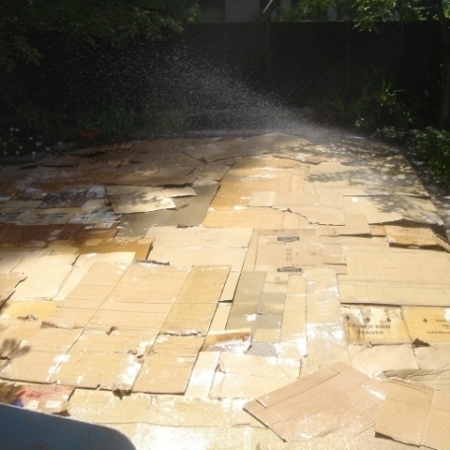- Author: Marian I Chmieleski
"So," she said, "I'd like to get rid of my Bermudagrass lawn. What's the best way?"
"The best way?" he replied. "Move!"
The constant battle with Bermudagrass gives fits to many gardeners and I am definitely one. I mentioned before that we were taking out our daughter's Bermuda front lawn. We started by having the top 3 inches of yard scraped by heavy machinery and carried away. Then we covered the entire area with clear plastic to solarize the soil, intending to remove the plastic and begin hardscape construction and planting after 6 weeks. However, I just attended a very informative workshop put on by the Bay-Friendly Landscape and Gardening Coalition and the plan has been modified. Here's what I learned that might help you, too.
Since Bermuda is so difficult --"sneaky and evil" in the presenter's words-- sheet mulching with a cardboard weed barrier is probably your best bet to beat it. In fact, it is a really good way to replace any lawn. First, you mow as closely as possible with a mulching mower, leaving the cut grass in place. (Okay, we scalped and solarized.) Then you cover the area with 2-3 layers of cardboard (all tape, plastic and staples removed), being sure to overlap all seams by about 6 inches so that no light will penetrate the cardboard. Water the cardboard well and cover with an inch or two of compost. The compost will add nutrients to the soil as the cardboard slowly decomposes over the next 24 months. If you have existing large plantings in the area, like trees that you want to preserve, be sure to leave a generous opening around the root crown for air circulation.
At this point a drip irrigation system can be installed on top of the compost and cardboard, followed by 3-6 inches of mulch. Just be careful to keep the mulch 2 to 3 inches away from the trunks or stems of plants. The mulch is a critical part of the process and can be anything from tumbled glass or gravel to arbor chippings or bark. If you are fighting Bermuda grass be sure not to disturb the cardboard for a full 6 months and go for the 6-inch mulch job. If not, 3 inches of mulch will suffice and you can go ahead and cut holes in the cardboard and install your new plants. Regardless, you can plant from either 4-inch pots or 6-paks right away on top of the cardboard by just nestling the plants into a nice little planting-mix mound in your mulch.
Sheet mulching is just one in a wealth of ideas offered by Bay-Friendly Gardening, whose 7 principles seek to: build healthy soils, reduce waste in the garden, conserve water, create wildlife habitats, protect the local watersheds and the Bay, save energy and contribute to a healthy community. Check out their website and their blog for more information. (www.bayfriendly.org and www.bayfriendlyblog.org)





